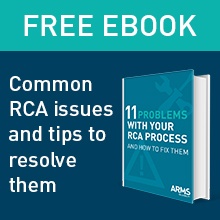By Ned Callahan
 Every organisation has unresolved problems. Some are greater than others.
Every organisation has unresolved problems. Some are greater than others.
The prospect of undertaking an RCA usually arises because there has been a persistent problem, a repetition of a failure or other “significant” event.
A problem which has never been “solved” will continue to cause headaches within the organisation and may well have very significant financial consequences. The question arises, why has it never been resolved?
- Is it a matter of scarce resources?
- A lack of expertise?
- or, fear of the unknown?
More pressing priorities often take the lion’s share of available resources and this particular problem continually falls down the list. Those ‘other’ problems are more important because, generally, they have greater or more immediate impacts.
Recognition that there is a lack of expertise in the organisation to properly tackle the problem is not uncommon. This leads to a lack of confidence that an analysis will be productive or “successful” so why allocate already scarce resources? Will it just amplify the frustration? If it requires the engagement of external investigators, the whole gamut of decision-making about “who?” and “which method?” and “who’s paying?” confronts the organisation.
Work-around’s for managed problems
Perhaps the problem has actually become manageable. The consequences or impacts may already have been limited by some measures which contain or control the problem. Typically, this method of limiting the impacts becomes the norm and in no time at all the expression: “it’s always been like that” will be the standard response to queries about the persistent fault. This is the signal that we are coping in spite of the problem – a “work-around” is feasible.
Kick starting the process
These scenarios can be resolved quite simply. A single person can begin to determine whether an RCA is warranted by actually beginning the process. That requires the problem to be simply stated as the name or title of the ‘supposed’ problem. For example, two or three word expressions such as “broken pump shaft” or “repeated reportable emissions” or “declining customer satisfaction”. This simple focal point can generate a useful discussion about the “real” problem and that discussion can either begin to narrow towards causes or broaden towards the “big picture”.
But it’s best to first identify the simple facts about the location and time of the problem or incident and then to thoroughly quantify the impacts or consequences. Remember that this person is trying to determine whether an RCA is warranted and that necessitates measurement. Typical types of impacts; are Reputation, Financial, Safety, Legal, and Shareholder Confidence. In fact, the initial problem may well be replaced by one of the negative impacts as the “real” problem of which it becomes a cause.
Once these have been calculated (or estimated) and the problem quantified, you can then justify a recommendation for the analysis to continue and be formalised by the establishment of a team, a facilitator and a timetable or to suspend the analysis on the grounds that it hasn’t (yet) replaced other “issues” on the list.
Activation of Triggers
In a mature organisation, the decision whether or not to conduct a “formal” RCA is determined by the activation of triggers which are particular to that enterprise or organisation. In other words, the impacts such as Reputation, Financial, Safety, Legal and Shareholder Confidence are being felt and are more or less measurable.
For Reputation, the trigger might be more than five negative media references in the preceding twelve months. For Safety it may be any “Lost Time Injury” or “First Aid Event” and/or “Near Miss’’. For Legal, it might a predetermined number or value of litigations and fines incurred.
There is no definitive level or standard. The definition of triggers for an organisation is the recognition of its own threshold or degree of tolerance for negative consequences, its own “lines in the sand”.
In summary
The question of when to do an RCA is most easily answered by the response:
“when you will no longer tolerate the consequences of the problem and are therefore determined to prevent its recurrence or, at the very least to minimise any negative consequences”.
And that will only happen if a thorough and methodical process is undertaken to discover all the causes of the problem and to clearly illustrate the relationships between them. Clearly, there are causes you have not identified yet. There is something you don’t understand about the problem. Otherwise you’d have already identified effective solutions.
Keep in mind that sometimes the cost of prevention outweighs the cumulative total of historical and anticipated losses and a business case for the implementation of a particular solution doesn’t pass the ROI test. In other words, after the implementation of what are considered to be “reasonable” corrective actions and controls, management will be prepared to “self-insure”, to tolerate the risk of recurrence.
This can be done confidently after the RCA has revealed all the causes and all the possible solutions have been evaluated but not before.


